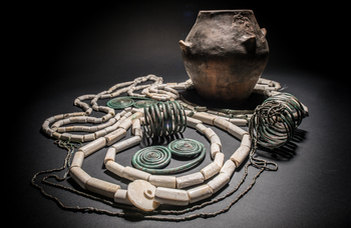An extraordinary Copper-Age Hoard from South Transdanubia
In 2016, during preliminary excavations preceding road constructions, a part of an early Copper Age (4350-3900 BCE) settlement was unearthed outside Magyaregres, in the central part of the Somogy Hills. One of the pits dug next to the houses yielded a hoard. A cooking pot placed upside down contained many pieces of copper and stone jewellery.
Although similar hoards have been taken to museums since the nineteenth century, the circumstances of their deposition were unknown.
The treasure discovered outside Magyaregres is the first assemblage of finds to have come to light during an archaeological excavation under well-documented conditions, so this was the first time that researchers had the opportunity to examine such so-called Stollhof-type jewellery pieces in a cultural, economic, and social context, associated with the life of the community that had hidden them. The Magyaregres assemblage found in an earthenware vessel comprised two large spectacle spiral pendants made of copper wire, three spiral copper bracelets, 19 pieces of tubular spiral copper tubes, 681 small copper beads, 264 stone beads, and a Spondylus bead (made from a piece of spiny oyster shell). Two of the three bracelets fit together. In other words, a larger spiral bracelet could have been purposefully cut in half by those who deposited the hoard.
During the research, the trace elemental composition of samples taken from copper jewellery pieces and the lead isotope ratios (found in the copper as contaminants) were measured. Based on the information obtained in this way, it was possible to determine the provenance of raw materials used for manufacturing the copper objects.
No such analysis has been carried out on a type of hoard like this before, which is why the results are highly important for understanding the beginnings of metallurgy in Central Europe.
Since the ceramic vessel turned upside down provided a protected environment, the copper finds were preserved in surprisingly good condition, which allowed not only chemical compositional examinations but also macrostructure analyses to reveal the manufacturing techniques used in the production of the copper objects.
From the results of the multidisciplinary analysis, researchers inferred that the raw material of the copper objects had most likely been extracted in the area of today’s Slovakia, in the North-Western Carpathians. In the settlement discovered near Magyaregres, no traces of the local production of copper objects could be detected during the excavation. Based on all this, the objects could have already been transported there as finished products.
According to the macrostructure analysis, the production of the objects started with thin hammering thin sheets of copper, and in the case of larger artefacts, several sheets were stacked and rolled up. This resulted in a thick piece of wire, from which large pendants and bracelets were formed by coiling and hammering them into the required shape.
For archaeologists – endeavouring to reconstruct the daily life of ancient communities and the social relations between their members – the objects and jewellery pieces deposited in burials next to the deceased represent important sources of information.
These are useful data for reconstructing the wear of ornaments that may differ by sex, age, rank, or status. However, the researchers are faced with particularly difficult situations when no such graves are found. Researchers have no information regarding such burials from the discussed period, the Early Copper Age in Transdanubia, either. What is more, not only in Transdanubia but also in the whole territory of Central Europe no contemporaneous grave has been found with spectacle spiral pendants or large bracelets in it!
Bracelets similar to the large spiral bracelets found in the Magyaregres hoard, yet smaller in size, came to light from contemporaneous female burials in the Great Hungarian Plain. Additionally, similar belts made from stone beads were also worn by women, based on the Copper Age burials unearthed in the Great Hungarian Plain and Budapest.
Taking all this into account, the objects in the Magyaregres hoard must have belonged to at least one but possibly to several women’s wears.
Based on a later depiction on a stone stele known from Switzerland, it is plausible that the spectacle spiral pendants also formed part of men’s wear, but we have no further evidence for this at the moment. The objects hidden in Magyaregres were certainly of particularly great value, which could only be accessed by some high-ranking members of the community.
The researchers published their findings aimed at identifying the provenance of the copper objects of the Magyaregres hoard and reconstructing the individual steps of the manufacturing process in the prestigious journal PLoS ONE in 2022, within the framework of a research project financed by the National Research, Development and Innovation Office (NKFI FK 124260).
Zsuzsanna Siklósi, Eszter Horváth, Igor Maria Villa, Stefano Nisi, Viktória Mozgai, Bernadett Bajnóczi, Péter Csippán, Péter Hornok, Péter Kiss: The provenance of the raw material and the manufacturing technology of copper artefacts from the Copper Age hoard from Magyaregres, Hungary. PLoS ONE 17(11) (2022): e0278116.
Cover image: The Copper Age hoard from Magyaregres. Photographed by Pazirik Informatikai Kft

